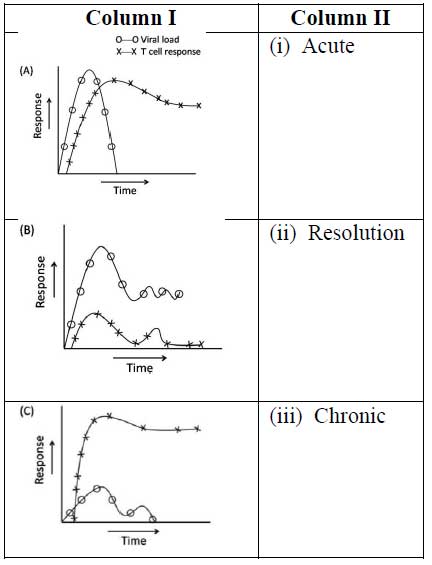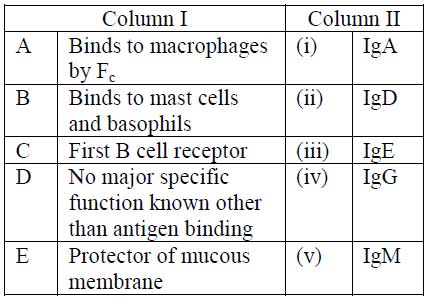Dear Students,
Welcome to Immunology MCQ-04. This MCQ set consists of Advanced (Post Graduate Level) Immunology and Defense System Multiple Choice Questions with Answer Key. All these questions were taken from the previous year question papers of CSIR JRF NET Life Sciences Examination. These questions can be used for the preparation of CSIR JRF NET, ICMR JRF, DBT BET JRF, GATE and other University Ph.D Entrance Examinations. After marking your answers, please click ‘SUBMIT‘ button to see your ‘SCORE‘ and ‘CORRECT ANSWERS‘.
You may also like: Immunology Lecture Notes | Immunology PPT
(1). In a plaque-forming cell assay, antigen specific B-cell numbers are assessed. In this assay, antigen coated sheep red blood cells (SRBCs) are lysed by the hapten-specific B cells by complement mediated cytotoxicity. In an assay that tried to enumerate the TNP-specific B-cells elicited in TNP-KLH-primed mice, no plaques were formed despite the presence of antigen-specific antibody producing B cells. Which of the following is NOT the reason for the absence of plaques? (CSIR_2015_I)
(a). The source of complement has anti-TNP antibody
(b). The SRBC were stored for too long
(c). The B cells were contaminated with LPS or lectins
(d). The complement had anti-KLH antibody
Ans. (c)
(2). CD4+ T cells are co-cultured with macrophages in the presence of immobilized anti0CD3 antibody under four different conditions:
(A). Interleukin (IL)-4 plus anti-IFNγ antibody
(B). IL-12 and anti-IL-4 antibody
(C). Transforming growth factor (TGF)-β
(D). TGF-β and IL-6
For three rounds to induce T-helper cells differentiation identifiable by the cytokines they express predominantly. Which one of the following is the most likely combination of predominant cytokine expression in these cultures? (CSIR_2015_I)
(a). (A). IL-4; (B). INF-γ; (C). IL-10; (D). IL-17
(b). (A). INF-γ; (B). IL-4; (C). IL-17; (D). IL-10
(c). (A). IL-17; (B). IL-4; (C). INF-γ; (D). IL-10
(d). (A). IL-17; (B). IL-10; (C). IL-4; (D). INF-γ
Ans. (b)
(3). In order to develop a vaccine against a regulatory T cell-promoting but Th1 suppressing viral infection, four groups (A-D) of mice were primed with either killed virus (A) or a virus derived immune dominant peptide (B), or the same peptide but with two substitutions (C) or were left unprimed (D. Upon infection challenge, the order of increasing severity of infection was observed to be B>A>D>C. To explain the contrasting effects of these two peptides (B) and (C), their MHC binding affinities were assembled but not differences were found. Which of the following possibilities most likely to explain their contrasting effects? (CSIR_2015_I)
(a). The wild type peptide (B) elicits T cells expansion but the mutant peptide (C) fails.
(b). The wild type peptide induces T cell deletion but the mutant peptide does not
(c). The wild type peptide MHC complex binds T cell receptor with significantly higher affinity than the mutant peptide MHC complex
(d). The wild-type peptide induces deflection of T-Reg cells but increases IFNγ production by T cells, whereas the mutant peptide fails to induce these effects
Ans. (a)
(4). Four groups of one day old female BALB/c neonates had received the following treatments:
(A). Epidermal cells from C57BL/6 male plus anti-β2 microglobulin antibody
(B). Epidermal cells from C57BL/6 male plus antibodies to β2 microglobulin, CD410 ligand, CD80 and CD86.
(C). Epidermal cells from C57BL/6 female plus anti-CD80 antibody
(D). Epidermal cells from C57BL/6 female mince
When these BALB/c neonates grew six weeks old, they received skin transplant from C57BL/6 male mice. Transplantation rejection time varied between these four groups starting from the fastest to the slowest rejection, which one of the following is the most likely order? (CSIR_2015_I)
(a). D ≥ C > A > B
(b). A > B > C ≥ D
(c). B > A > D ≥ C
(d). D > B ≥ C > A
Ans. (a)
(5). Cytotoxic T cells express: (CSIR_2015_II)
(a). CD8 marker and are class II MHC restricted
(b). CD4 marker and are class I MHC restricted
(c). CD4 marker and are class II MHC restricted
(d). CD8 marker and are class I MHC restricted
Ans. (d)
(6). The relation between cellular immune response generated against hepatitis C virus is the critical determinant of the outcome of infection. Given below are the representative figures of cellular immune response in column I and various outcome of infection in column II.
Choose the best possible combination : (CSIR_2015_II)
(a). A – (ii), B – (iii), C – (i)
(b). A – (i), B – (iii), C – (ii)
(c). A – (iii), B – (ii), C – (i)
(d). A – (i), B – (ii), C – (iii)
Ans. (b)
(7). There are various subclasses of antibodies found in body fluids and body secretions. Many different functions may be attributed to these subclasses. Given below in column I is major functions of different subclasses and column II consists of the name of the subclass.
Select the correct combination: : (CSIR_2015_II)
(a). A – (i), B – (ii), C – (iii), D – (iv), E– (v)
(b). A – (ii), B – (iii), C – (iv), D – (v), E– (i)
(c). A – (iii), B – (iv), C – (v), D – (i), E– (ii)
(d). A – (iv), B – (iii), C – (v), D – (ii), E– (i)
Ans. (d)
(8). Following are some of the characteristics of MHC class I and class II molecules except one which is applicable only for MHC class I. Identify the appropriate statement. (CSIR-2016-I)
(a). They are expressed constitutively an all nucleated cells.
(b). They are glycosylated polypeptides with domain structure.
(c). They are involved in presentation of antigen fragments to cells.
(d). They are expressed on surface membrane of B cells.
Ans. (a)
(9). Immunoglobulins have therapeutic appli-cations in cancer treatment, infection clearance and targeted drug delivery. For this reason, immunoglobulins are briefly cleaved by the enzyme pepsin. Following are some of the statements regarding the brief digestion of immunoglobulin by pepsin.
(i) F(ab)2 fragment is generated which retains the antigen binding activity.
(ii) F(ab) fragment having antigen binding activity and the crystallisable Fc fragment are generated.
(iii)The fragment generated on incubation with a proper antigen forms a visible precipitate.
(iv)The fragment generated is incapable of forming a visible precipitate on incubation with a proper antigen.
Which of the above statements are correct? (CSIR-2016-I)
(a). (i) and (ii)
(b). (i) and (iii)
(c). (i) and (iv)
(d). (ii) and (iii)
Ans. (b)
(10). In an experiment peritoneal macrophages were isolated from strain A of guinea pig. These cells were then incubated with an antigen. After the antigen pulsed macrophages processed the antigen and presented it on their surface, these were mixed with T cells from (i) strain A or (ii) strain B (a different strain of guinea pig) or (iii) F1 progeny of strain A X B. T cell proliferation was measured in response to antigen pulsed macrophages. T cells of which strain of guinea pig will be activated? (CSIR-2016-I)
(a). Strain A only
(b). Strain B only
(c). Strain A and F1 progeny
(d). Strain B and F1 progeny
Ans. (c)
(11). Which one of the following human serum immunoglobulins takes part in classical complement fixation pathway? (CSIR_2017_II)
(a). IgD
(b). IgE
(c). IgA
(d). IgG
Ans. (d)
(12). Major histocompatibility complex (MHC) molecules are encoded by a cluster of genes called MHC locus. There are several reasons why an MHC molecule on the surface of a cell is important. Which one of the following reasons is INCORRECT? (CSIR_2017_II)
(a). To display self class I to demonstrate that the cell is normal and healthy.
(b). To display foreign-peptide in class I to show that the cell is infected and to engage with T helper cells.
(c). To display a self-peptide in class I and II to test developing T cells for autoreactivity.
(d). To display a self-peptide in class I and II to maintain tolerance to self-proteins.
Ans. (b)


